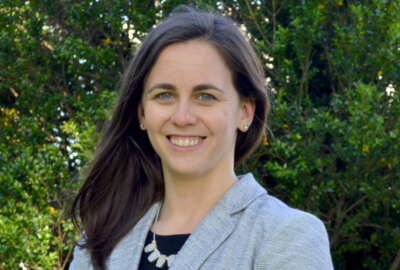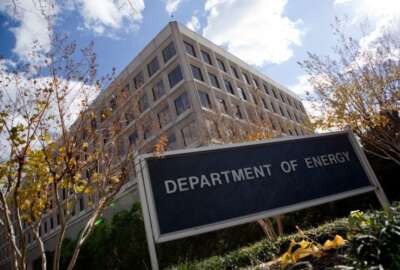
Checking in with the newly-confirmed director of the Energy Department’s innovation unit
Whatever the country's energy future will turn out to be, it will require advances in science and technology. That's where my next guest comes in.
Whatever the country’s energy future will turn out to be, it will require advances in science and technology. The Senate confirmed late last month a new director of the Energy Department’s Advanced Research Projects Agency. For more, the Federal Drive with Tom Temin spoke with Dr. Evelyn Wang.
Interview transcript:
Tom Temin
My first question is what attracted you to come to [Advanced Research Projects Agency-Energy (ARPA-E)] from a great job leading mechanical engineering at MIT? Is it because, maybe the federal government is the only thing that’s less political than higher education?Evelyn Wang
That’s a really good question. I’ve certainly enjoyed my time as a professor in mechanical engineering at MIT. In fact that, as a professor, in my area of research which is in heat transfer, I’ve worked with ARPA-E, from almost the start of ARPA-E. And I was funded in a program called [High Energy Thermal Storage (HEATS)], where we were working on a thermal battery for electric vehicles. And that’s what inspired me to think about these high impact, potentially transformative energy solutions. And it really has led the way and paved the way for me, as I continue to work in research in various areas that ARPA-E had supported. And that’s what really led me here. Because I’m excited about the mission and about the opportunities and the needs that we have in the very near future.Tom Temin
And I’m looking at your bio, and you have done research in heat and mass transport processes with nano engineered materials. You mentioned thermal battery work. That doesn’t sound exactly like what I think of, when I think of mechanical engineering. I guess until you get to the nano engineered part. So how does mechanical engineering and energy transfer all tie together?Evelyn Wang
Mechanical engineering is a very broad field. And traditionally, often you can think about a mechanical engineering system like a heat engine. And so that, in fact, does involve thermodynamics, heat transfer, fluid mechanics. And so I would say that while there are a lot of new opportunities beyond heat engines now, which leverages new materials design, controls, and all other aspects of the field of mechanical engineering. I will say that heat transfer is a very important part, especially in thinking about the future of energy.Tom Temin
Got it. And so thermal batteries and heat engines. These are words that are not quite into the popular lexicon yet though. Are they?Evelyn Wang
That’s right. So a thermal battery is something that ARPA-E came up with. In the sense that when they were looking at electric vehicles, and trying to think about what limits deployment of electric vehicles. The battery gets significantly drained, because of the HVAC system. So the heating and cooling of your cabin drains a lot of the battery and can reduce the driving range about 30-40%. So ARPA-E proposed a program, focused on developing a thermal battery that’s meant to not drain the electric vehicle battery supply. And have a separate source for providing heating and cooling to the electric vehicle.Tom Temin
I guess nobody wants to live without air conditioning and crank windows anymore.Evelyn Wang
That’s right. Comfort is a priority for most consumers.Tom Temin
All right. So arriving at ARPA-E, you’ve only been there barely a month. What have you seen so far? How does it impress you?Evelyn Wang
I’ve been so excited to be here. It’s actually been only about two and a half weeks in, so I still have a lot to learn. But it’s already a very busy time, because we have many things going on upcoming. So some of the things that we’re working on right now is improving semiconductor material to create a more capable grid, undergrounding our grid, validating marine carbon dioxide removal techniques, and exploring ways to support an intermodal freight transportation network. And so for example, moving freight by two or more modes of transportation, such as with trucks, trains and cargo ships is an opportunity space we’re looking at. I will also mention that, what’s also in our horizon is the ARPA-E Energy Innovation Summit. This is an annual summit where it brings people together from ARPA-E performers to members of the [venture capitalist] community to think about America’s energy challenges in new and innovative ways. And this year, the summit will be held nearby at the Gaylord National Convention Center in the National Harbor in Maryland. From March 22-24. So we hope that there will be many people that attend. And if there’s interest in joining us, you can go to ARPA-E-summit.com to learn more.Tom Temin
All right, we’re speaking with Dr. Evelyn Wang. She’s director of the Advanced Research Projects Agency at the Energy Department, ARPA-E. And as the director, you bring a lot of science and research background. But there are a lot of processes in terms of deciding who gets grants and how much money the different grantees get, which projects should be funded and by how much. So how do you divide your brain between the bureaucratic processes of making sure the money is used wisely, and also understanding what is worthy of being funded, and what is just pie in the sky and really maybe not worth exploring any further?Evelyn Wang
We have a great team here. And in particular, the program directors work on trying to define the white spaces, by which there are opportunities for us to really transform the energy landscape. In fact, they pitch ideas that become eventual programs, then we go out and solicit from various people, whether it’s from researchers, from industry or in academia, or national labs. And we really try to solicit all sorts of the kind of out of the box thinking, innovative ideas to address the problem space. And ARPA-E is an agency where we try to work on a variety of options to solve a problem. So it’s a portfolio approach that allows us to now be able to take risk. But also see the options that are available so that when we think about the policymakers, we can inform policymakers what is possible within the energy technologies.Tom Temin
Because the Energy Department has had a program, for some time running now, that is looking into a next generation of nuclear reactor. And that’s not windmills, and that’s not solar, and it’s not batteries. Small, easily, more cheaply deployable, and safer and all of this. Will that continue? Is this part of the portfolio also?Evelyn Wang
ARPA-E works on all sorts of energy solutions and technologies. We also collaborate across all the other parts of the [Energy Department]. And so with a nuclear aspects, we always love to collaborate with them. But we also like to think of potentially the higher risk opportunities that are important to be able to make nuclear a reality in the future.Tom Temin
And so that’s a yes, that it is part of the possible mix.Evelyn Wang
Yes.Tom Temin
All right. And what about things that combust? Do they have a future, if somehow someone could say, hey, look, we have a way of combusting natural gas, or gasoline or even diesel fuel in such a way that X, Y, Z is the output. That would also be possible and considered on the table too?Evelyn Wang
As I mentioned, we look at a variety of energy solutions. But what’s very important when we think about combustion is CO2 emissions. And so ARPA-E has also worked on looking at how do we mitigate CO2 emissions, as we know that it’s critical for us to get to net zero by 2050. And so we are looking at a variety of solutions, but we have to consider the impacts on the environment.Tom Temin
So if there was some way of putting the CO2 into the air conditioning system, where it stayed there, we’d really have something.Evelyn Wang
Absolutely. And I think solutions that have been looked at such as direct air capture, there’s opportunities to think about how we make it more scalable, low cost, so that they can be readily available, and all sorts of different technologies.Tom Temin
And just a quick question, if you would. That caught my ear is the new semiconductor technology, in order to make the grid more reliable. Can we just get a little detail on that idea?Evelyn Wang
Sure. We’ve been working on semiconductors for quite some time. And a lot of it is actually control of the grid to be able to now distribute the electricity, where you need it when you need it, especially during emergencies. And so power electronics play a very critical role, and thinking about grid infrastructure and the reliability of the grid. And so this is an area that ARPA-E has pursued for some time, but in different opportunities spaces. And as we think about the future, I think there are ways to be switching faster in terms of the power electronics designs. And mechanisms to be able to do that, say through optical methods, RF, as well as other means.Tom Temin
And in power electronics, you’re sometimes talking about transistors that are the size of a hockey puck.Evelyn Wang
That’s right, and sometimes smaller. So each individual transistor can be smaller than the diameter of your hair.Tom Temin
Right. So this type of research then focuses on the large power switching gear, as well as the control mechanisms that would cause the switch to take place. So microelectronics and macro, you might say together.Evelyn Wang
That’s right. I would say it’s multiple scaled approach to be able to address these problems.
Copyright © 2024 Federal News Network. All rights reserved. This website is not intended for users located within the European Economic Area.
Tom Temin is host of the Federal Drive and has been providing insight on federal technology and management issues for more than 30 years.
Follow @tteminWFED
Related Stories





